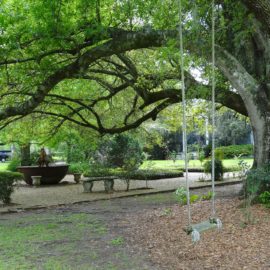
Tree branches littered the streets after Ida and uprooted trees were common.
As the sky cleared after Hurricane Ida, the sight of the jagged remains of the once-splendid magnolia shocked Lance Vargas. It was under this tree, at the edge of Jackson Square in New Orleans, that Vargas had seen his business flourish. Over 12 years, the artist accumulated countless memories beneath her long, leafy limbs as he sold pieces made of recycled wood alongside other French Quarter artists. The tree was nicknamed Maggie Magnolia, and her boughs offered a cool sanctuary on hot summer days, inviting prospective customers to linger. “She was an old tree from an ancient species. I learned to appreciate what happens under a tree, magical moments under her refuge,” Vargas said, now devastated by the splintered trunk and fallen crown. Maggie was one of the untold thousands of trees sent crashing to the ground across the region on Aug. 29 by the Category 4 storm’s 140 mph wind. Ida tested the region’s tree canopy just 10 months after Hurricane Zeta, a Category 3 storm that also grounded trees and limbs across the New Orleans area. But Ida was far worse.
nola.com
It did not help that we had many rainy days with rain that left soaked ground when Ida hit. Soft ground, heavy winds and trees fall.
Due to a deadly combination of heavily saturated soil in an especially rainy year and Ida’s higher winds, Jefferson Parish lost far more trees than in Zeta, said Bryan Parks, the parish government’s parkways director. Just on public rights of way, he estimated 1,000 were grounded or at least heavily damaged. With Zeta, there were 300. “I think this statistic shows the power of the storm,” Parks said. “Zeta cleared out a lot of unhealthy and weak trees, so in theory, we had a pretty strong tree canopy going into Ida.” Not invincible, however. Many of those felled by Ida were older water oaks, which make up a large portion of Jefferson’s residential trees. They grow quickly but are notorious for their brittle wood, and they have a lifespan of less than 60 years. Across southeast Louisiana, Ida’s final tree toll might never be known, due to many of them being lost on private property where owners are under no obligation to report the numbers. Even local governments haven’t yet tallied all the numbers on public property.
The damage will be substantial. That fact is based on what can be seen as one drives around the city.
But it’s clear the damage was substantial. In the 610-acre Parc de Familles in Marrero, Ida left more than 200 trees splayed across such attractions as the disc golf course and boardwalk. The 155-acre Lafreniere Park in Metairie also lost a large number of trees. In St. Tammany Parish, officials said Ida snapped hundreds of pine trees, dropping them across streets and power lines. At his heavily wooded property in Mandeville, Ernest Burguieres lost seven trees to Ida, a mixture of red and water oaks. “None of them hit the house, but it opened up a lot of sunlight,” he said. The shade from his trees usually helps keep his home cooling bills low, and the new sun rays poking through since Ida remind him a bit of the destruction left by Hurricane Katrina in 2005. “In Katrina, I lost 44 trees,” he recalled. “My electric bill doubled during the summer time.”
I did not do too bad as we have a lot of crepe myrtles that swayed and bent. We had others than were knocked down but easily righted. There are a lot of oaks on our street though.
Looking down his street, however, oaks of another kind live on. The massive live oaks, whose thick trunks grow in the middle of the road, stood resolutely against the storm. “You only see that in old communities,” Burguieres said. “They’ve been through dozens of hurricanes.” Live oaks are among the most hurricane-resistant trees, dropping their leaves in high winds to lessen their load while maintaining a strong root system. The iconic ones flanking Northline in Old Metairie and St. Charles Avenue in Uptown New Orleans, for example, emerged largely unscathed from Ida. Some other live oaks did not. In New Orleans’ City Park, one 3-foot-wide live oak, – likely more than a century old – toppled over within the traffic circle near the park’s administration building. Four weeks after the storm passed, a sideways stump with exposed roots offers the only lingering evidence of its long life. It was among at least 50 downed trees in the 1,300-acre park. “That oak tree is absolutely in every way shape and form irreplaceable,” said Cara Lambright, City Park’s CEO.
Walking the dog in the morning and coming to the intersection of St. Charles and Napoleon the first block up 5-6 crepe myrtles were over up rooted. They hasve not been fixed yet. The oaks did well, losing some branches.
Audubon Park in New Orleans, with 300-plus acres, lost about 13 mature trees. Of them, four were wider than 40 inches. Some were already in a weakened state due to termite damage. And while replanting will be manageable, the sight of grand old trees prostrated is always difficult for Steve Marshall, the park’s vice president and managing director. “When you experience one of these majestic oaks everyday, and you see it torn apart and laying on the ground, it’s impactful,” he said. Trees carry great aesthetic value. But there’s an environmental value, as well, Lambright said, when considering their ability to pull carbon from the atmosphere, reduce flooding, conserve soil and mitigate heat. “I’ve been kind of saying a million dollars, and it’s increasingly clear that I think that number is really quite low,” she said of Ida’s damage to City Park.
There is always the comparison with hurricanes and Katrina usually wins.
If Ida was worse than Zeta, however, it was not as bad as Katrina. A U.S. Forest Service study found that New Orleans lost almost 10% of its urban tree canopy from 2005 to 2009 and attributed much of loss to the 2005 hurricane. After that storm, Jackie Madden of Metairie helped organize dozens of replanting efforts as part of her volunteer work with Friends of Jefferson the Beautiful. “There’s beauty in a tree,” said Madden, who finds peace when gazing at intricately intertwined branches. “I look at a tree, and I think art.” After Ida, she said, “It looks like we’ll have many projects to come.”
Many projects. Many people can say that.
Indeed, Tim Benton, a New Orleans arborist who also runs his own tree-planting nonprofit, said the canopy remains insufficient and that replenishing it must be prioritized. “There’s something instinctual with people that just connects with trees. That shouldn’t be dismissed,” he said. “If we lose that, then we’re losing something that is part of what it means to be human.” Amid all the damage, Michael Karam, New Orleans’ Parks and Parkways director, offered one bright spot: Ida’s timing. The storm arrived just before the start of the fall planting season. His department plans to get even more trees into the ground alongside other groups, drawing from funding for park enhancements from a recent municipal bond sale. “All of our efforts to focus on the coming planting season are that much more important now that we have the losses associated with Ida,” he said. “Obviously, in the short term it won’t make up for that canopy loss. But you know, give it a couple years.”
THe mayor wants more trees and parks. We have too many hot spots. So maybe more trees will be planted than lost. That would be a good thing.



